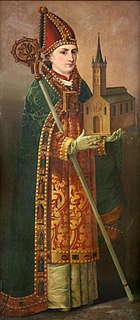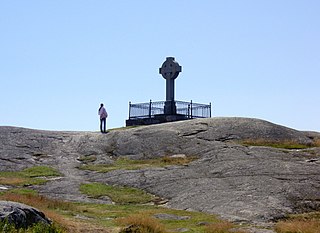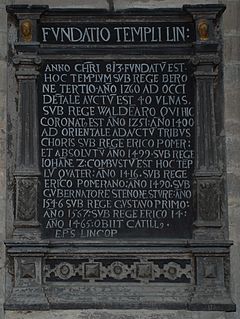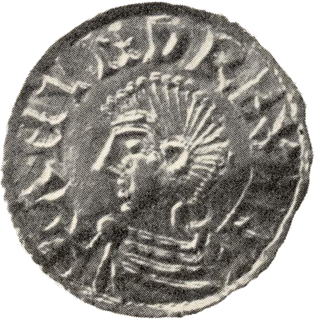Related Research Articles

Ansgar, also known as Anskar, Saint Ansgar, Saint Anschar or Oscar, was Archbishop of Hamburg-Bremen in the northern part of the Kingdom of the East Franks. Ansgar became known as the "Apostle of the North" because of his travels and the See of Hamburg received the missionary mandate to bring Christianity to Northern Europe.

Birkalisten (help·info), on the island of Björkö in present-day Sweden, was an important Viking Age trading center which handled goods from Scandinavia and Finland as well as Central and Eastern Europe and the Orient. Björkö is located in Lake Mälaren, 30 kilometers west of contemporary Stockholm, in the municipality of Ekerö.

Swedish pre-history ends around 800 AD, when the Viking Age begins and written sources are available. The Viking Age lasted until the mid-11th century. Scandinavia was formally Christianized by 1100 AD. The period 1050 to 1350—when the Black Death struck Europe—is considered the Older Middle Ages. The Kalmar Union between the Scandinavian countries was established in 1397 and lasted until King Gustav Vasa ended it upon seizing power. The period 1350 to 1523 – when king Gustav Vasa, who led the unification of Sweden, was crowned – is considered the Younger Middle Ages.

Olof Skötkonung, sometimes stylized as Olaf the Swede, was King of Sweden, son of Eric the Victorious and, according to Icelandic sources, Sigrid the Haughty. He succeeded his father in c. 995. He stands at the threshold of recorded history, since he is the first Swedish ruler about whom there is substantial knowledge. He is regarded as the first king known to have ruled both the Swedes and the Geats. In Sweden, the reign of king Olov Skötkonung is considered to be the transition from the Viking age to the Middle Ages, because he was the first Christian king of the Swedes, who were the last to adopt Christianity in Scandinavia. He is associated with a growing influence of the church in what is today southwestern and central Sweden. Norse beliefs persisted in parts of Sweden until the 12th century.

Eric the Victorious was a Swedish monarch as of around 970. Although there were earlier Swedish kings, he is the first Swedish king in a consecutive regnal succession, who is attested in sources independent of each other, and consequently Sweden's list of rulers usually begins with him. His son Olof Skötkonung, however, is considered the first ruler documented to definitely have been accepted both by the original Swedes around Lake Mälaren and by the Geats around Lake Vättern. Adam of Bremen reports a king named Emund Eriksson before Eric, but it is not known whether he was Eric's father, and the Norse sagas' accounts of a Björn Eriksson are considered unreliable.
Emund Eriksson, , was a Swedish king whose historicity is only known from a single source, the Gesta Hammaburgensis ecclesiae pontificum which was written by Adam of Bremen in c. 1075.
Anund Uppsale or Anoundus, 'Anund of Uppsala',, a son of Erik Björnsson of the House of Munsö, ruled Sweden together with his brother Björn at Haugi, according to Hervarar saga. He is called Uppsale because he stayed at Old Upsala, the era's religious centre. He and Björn are sometimes identified with similarly-named kings mentioned in Rimbert's Vita Ansgari and by Adam of Bremen.
Olof was a Swedish monarch or local ruler who ruled over Birka, an important port town, and possibly Uppsala, an important early Swedish political center, in about 852, when the Catholic missionary Saint Ansgar made his second voyage from Germany to Birka in about the year 851 or 852 A.D. He had an ambivalent attitude to Christianity, and was known as a successful warrior king in the Baltic region.

Björn according to the Hervarar saga and Harald Fairhair's saga was the father of Olof (II) Björnsson and Eric the Victorious, also a grandfather of Styrbjörn the Strong. According to the two sagas, he was the son of an Erik who fought Harald Fairhair and who succeeded the brothers Björn at Hauge and Anund Uppsale:
Eric Anundsson or Eymundsson was a semi-legendary Swedish king who supposedly ruled during the 9th century. The Norse sagas describe him as successful in extending his realm over the Baltic Sea, but unsuccessful in his attempts of westward expansion. There is no near-contemporary evidence for his existence, the sources for his reign dating from the 13th and 14th centuries. These sources, Icelandic sagas, are generally not considered reliable sources for the periods and events they describe.
Erik Ringsson was a Swedish king and the son of Ring, according to the German ecclesiastic chronicler Adam of Bremen. He is said to have ruled together with his father and his brother Emund in about 936, and later presumably reigned in his own name.

The House of Munsö, also called the House of Björn Ironside, the House of Uppsala or simply the Old dynasty, is the earliest reliably attested royal dynasty of Sweden, ruling during the Viking Age. None of the names suggested for the dynasty are universally accepted and most are problematic; the name "House of Munsö" derives from a questionable and speculative theory that they would have ruled from the island of Munsö and the name "House of Björn Ironside" derives from the supposed founder of the dynasty, Björn Ironside, who is often seen as a legendary, rather than historical, figure.

Anund Jacob or James, Swedish: Anund Jakob was King of Sweden from 1022 until around 1050. He is believed to have been born on July 25, in either 1008 or 1010 as Jakob, the son of King Olof Skötkonung and Queen Estrid. Being the second Christian king of the Swedish realm, his long and partly turbulent reign saw the increasing dissemination of Christianity as well as repeated attempts to influence the balance of power in Scandinavia. Through out his regin he tried to subvert the raising Danish hegemony in Scandinavia by supporting the Norwegian monarchy. He also supported the reign of Yaroslav the Wise in Kievan Rus, his brother-in-law. He is referred to in positive terms in German and Norse historical sources. His reign was one of the longest in Sweden during the Viking age and Middle Ages.
Emund the Old or Edmund was King of Sweden from c. 1050 to c. 1060. His short reign was characterised by disputes with the Archbishopric of Bremen over church policies, and a historically debated delimitation of the Swedish-Danish border.

Stenkil was a King of Sweden who ruled c. 1060 until 1066. He succeeded Emund the Old and became the first king from the House of Stenkil. He is praised as a devout Christian, but with an accommodating stance towards the old Pagan religion. His brief reign saw an armed conflict with Norway.
Olof was a king who, according to a late source, ruled in Denmark in about 900 after usurping power. Evidence for his historicity is only circumstantial, since he belongs to a period of Danish history when very little is known from textual sources.
Gunnhildr Sveinsdóttir or Gunnhildr Haraldsdóttir, Guda or Gyda was, according to the traditional view, a queen consort of King Anund Jacob of Sweden and of king Sveinn II of Denmark. However, the sources are so vague that several modern historians maintain that there were actually two queens of that name, of Sweden and Denmark respectively. She is sometimes called Gude or Gyridje, but this is probably because of confusion with her daughter, Gyda, who is also known under her mother's name Gunnhildr.
Astrid Njalsdotterof Skjalgaätten, was a Norwegian noblewoman who married Ragnvald the Old and became the ancestress of the Swedish Stenkil dynasty. She is sometimes assumed to have been a Swedish queen, though the evidence is inconclusive.
Björn was a Swedish monarch or local ruler who ruled over Birka, an important port town, and possibly Uppsala, an important early Swedish political center, around the year 829. His existence is attested by the nearly contemporary account Vita Ansgari, written by the missionary Rimbert, who visited Sweden alongside Ansgar in c. 829. Attempts have been made to identify the king with the legendary figure Björn at Haugi, but these attempts have to be considered unverifiable and unreliable. Though the genealogy of early Swedish local rulers is not known, Björn is assumed to have been of the House of Munsö, which would later produce Eric the Victorious, generally considered to be Sweden's first king.
References
- ↑ Adam av Bremen (1984), Historien om Hamburgstiftet och dess biskopar. Stockholm: Proprius förlag, p. 57-8 (Book I, Chapter 57).
- ↑ Adam av Bremen (1984), p. 58 (Book I, Chapters 58-59).
- ↑ Adam av Bremen (1984), p. 60 (Book I, Chapter 60).
- ↑ Adam av Bremen (1984), p. 60-2 (Book I, Chapter 61).
- ↑ Adam av Bremen (1984), p. 62 (Book I, Chapter 62).
- ↑ Birger Nerman (1916) "Torgny lagman", Arkiv för nordisk filologi 28 311 ; Carl Bernadotte et al. (eds) (1956), Sveriges hundra konungar. Stockholm: Biblioteksböcker, p. 74-6, 92.
- ↑ Adam av Bremen (1984), p. 61.
- ↑ Åke Hyenstrand (1996), Lejonet, draken och korset; Sverige 500-1000. Lund: Studentlitteratur.
- ↑ Adam av Bremen (1984), p. 52-3 (Book I, Chapter 48). For an archaeological view of Swedes in Hedeby, see Heiko Steuer (1984), "Zur ethnischen Gliederung der Bevölkerung von Haithabu anhand der Gräberfelder", p. 209
- ↑ Niels Lund (1982) "Svenskevældet i Hedeby", Aarbøger for Nordisk Oldkyndighed og Historie 1980 København: Det Kongelige Nordiske Oldskriftselskab - Nationalmuseet, p. 114-125.
- ↑ Carl Bernadotte et al. (eds) (1956), p. 93.